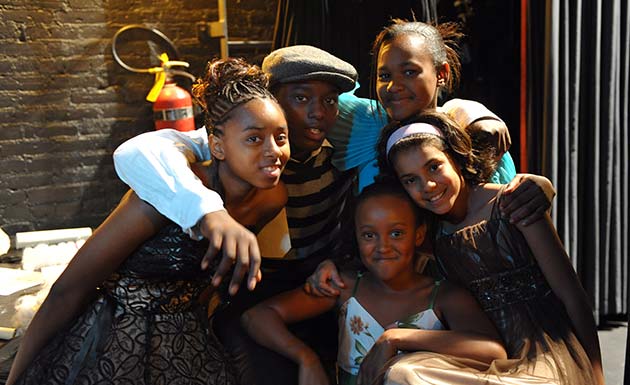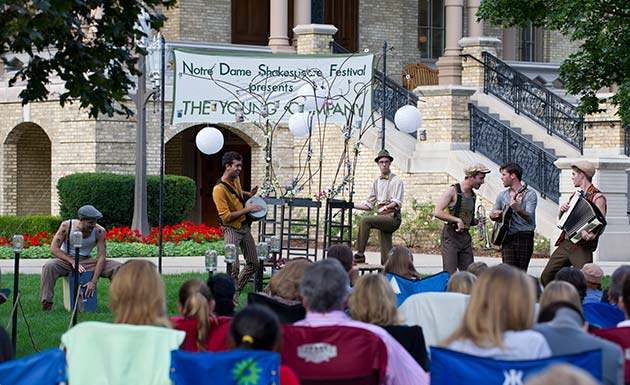Visitors to the Hesburgh Libraries’ Rare Books and Special Collections gallery during January will have an uncommon opportunity to see up close one of the most revered collections in all of literature. The month-long display of the First Folio, a collection of plays by William Shakespeare published in 1623, is part of a nationwide tour sponsored by the Folger Shakespeare Library, the pre-eminent repository of Shakespeare memorabilia in the U.S.
The book is the first published collection of 36 of Shakespeare's plays, 18 of which are believed to never have been published prior to the 1623 edition. It includes some of the most well-known works from The Bard: Julius Caesar, Hamlet, Twelfth Night, and As You Like It to name a few. It is, in every sense of the word, priceless, and its display is the centerpiece of a host of complementary exhibits, performances and lectures in January that offer a chance for visitors of all ages to begin to break — or pre-empt — what Shakespeare at Notre Dame executive director Scott Jackson calls one of the common hurdles to appreciating the works of the renowned poet and playwright, “the sophomore jinx.”
“We’re sitting in literature class as sophomores in high school, having to read Shakespeare from a book, in a classroom, facing forward, and it ruins it for us,” Jackson says, “because it’s not set in the appropriate performative context. We’re not thinking about these characters as real people, or as parts of ourselves.”
Conveying Shakespeare experientially — off the page and into the hearts and minds of the audience — has become a central mission of Shakespeare at Notre Dame, and one reason their proposal to host the First Folio was accepted by the Folger Library. Notre Dame is the first stop on a nationwide tour of eight such Folios, and the only stop in Indiana.
Caring for the Folios on the tour is an endeavor unto itself. For example, the climate in and around their otherwise nondescript display cases is constantly monitored to ensure the environment does not place undue stress on the tender pages and binding of the centuries-old books. It is meticulous protection of a set of books that came to be almost by happenstance. What we know as the First Folio is the result of efforts by Shakespeare’s colleagues to commemorate The Bard’s work after his death. These friends compiled the plays from manuscripts and from memory, and formed the collection that has been dubbed “the book that gave us Shakespeare.” In its display, the book is opened to the famous “To be, or not to be” monologue from Hamlet.
The display in the Hesburgh Libraries features Shakespearean costumes, and a life-size banner depicting the Globe Theater in London.
That Notre Dame was selected as a site on the tour is a testament to the robust programming around the works of Shakespeare at the University, which includes the Robinson Shakespeare Players at the Robinson Community Learning Center, the Shakespeare in Prisons Network, the Notre Dame Shakespeare Festival and the residency program Actors From The London Stage.


“One of the programs I’m most proud of as dean is Shakespeare at Notre Dame,” says John T. McGreevy, the I.A. O’Shaughnessy Dean of the College of Arts and Letters. “It is one of those rare programs that crosses the humanities and the arts, and crosses into South Bend, educating our students, our faculty, and our citizens.”
“I think those programs starting at the grassroots community level, and going up to the graduate and postgraduate levels, have given us a very specific, but broad presence in the Shakespeare community,” Scott Jackson, Shakespeare at Notre Dame Executive Director
“Because of that, we very quickly became one of the most visible Shakespeare companies, certainly in the Midwest, but also in the country and in certain circles, the world,” Jackson says.
The First Folio exhibit is just one of many events at Notre Dame while a world-wide community commemorates the 400th anniversary of Shakespeare’s legacy. Later in the month, Shakespeare at Notre Dame will host the international conferences of the Shakespeare Theatre Association and the Shakespeare in Prisons Network, at which experts from the stage and the academy will explore approaches to teaching and presenting Shakespeare’s works to both traditional and nontraditional audiences.
The ribbon cutting ceremony for the First Folio exhibit. From left: John T. McGreevy, I.A. O'Shaughnessy Dean of the College of Arts and Letters; Rev. John I. Jenkins, C.S.C., University president; Pete Buttigieg, mayor of South Bend; Diane Parr Walker, Edward H. Arnold University Librarian.
“What Notre Dame brings to that conversation is the idea of the theater arts being a catalyst for positive social change,” Jackson says. Shakespeare’s works in themselves provide a means of expression of the universal themes of the human experience they explore. Therein lies the wide appeal and emotional attraction to the characters and stories of Shakespeare.
“To take those themes and make them accessible to students and to those who are disenfranchised, and to give them a tool to break some of the bonds of isolation — to see that we’re not alone, and there is a path to transformation and light — that is an incredibly powerful tool when you allow each student to engage with the words and rhythms of the plays from their own unique perspective as opposed to dictating a uniform meaning for them,” Jackson says.
To see the details of the First Folio exhibit, including the hours available for the public and a list of accompanying events, visit Shakespeare at Notre Dame.